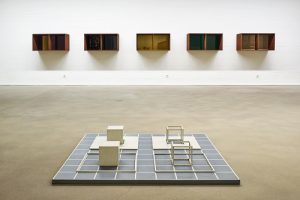Sculpture
Positions in Modern art
The collection of international Modern sculpture and object art takes pride of place in the Lehmbruck Museum. It comprises important examples of Classical Modernism, Expressionism, Surrealism and Constructivist sculpture. The collection includes works by outstanding artists such as Ernst Barlach, Joseph Beuys, Constantin Brâncuși, Salvador Dalí, Rebecca Horn, Käthe Kollwitz, René Magritte, Henry Moore, Niki de Saint Phalle or Richard Serra who have all played crucial roles in the development of art. Moreover, the Lehmbruck Museum owns the single largest group of works by Alberto Giacometti in Germany.
The presentations in the Glass Hall and in the street gallery so-called forge links to the oeuvre of Wilhelm Lehmbruck in art historical terms. The three-dimensional art works showcased here mark changes, innovations, and outstanding positions in the history of sculpture. At the beginning of the 20th century, art disengaged from figuration, mimesis and the academies, as a new understanding of form arose that in its most radical consequence resulted in an utterly free approach to space, volume and material. While up until this point sculpture had been modelled, formed, chiseled, poured, it was now possible to construct, plan, and build it. Artists assumed the role of architects and engineers. Even the human body was mechanized. Furthermore, sculptures now started also to take intangible phenomena such as light, music and space as their subject matter – for example in the shape of the first abstract sculpture, “Dreiklang” by Rudolf Belling, which came to be seen as the epitome of abstraction.

Auguste Rodin, Portraitmaske Rose Beuret, 1888-90, Photo: Fabian Strauch
The Lehmbruck Museum extension which opened in 1987 presents the most important trends in art history since the 1960s by way of examples. It houses large installations, iconic sculptures, and objects; among them are central works of Arte Povera by Jannis Kounellis, key specimens of Minimal Art by Donald Judd and Sol LeWitt, not to mention Günther Uecker’s mysterious nail cube “Grab der verlorenen Erinnerung”. A separate section is dedicated to Joseph Beuys and his circle around 1970. Important pieces by Anish Kapoor and Frank Stella stand in prominent spots.

Sol LeWitt, 4-part-piece 'ABCD 2', 1968 (front), Donald Judd, Fünfteilige Wandskulptur, 1992 (back) © VG Bild-Kunst, Bonn 2020, Photo: Dejan Saric
The “Fairytale Relief” by Jean Tinguely shows the artist’s playful delight in mechanics and movement, as does the rocking horse by media pioneer Nam June Paik. Surprising art works are to be found tucked away in the alcoves of the lower floor: The popular “Reserve des enfants de Duisburg” by Christian Boltanski is an archive of the works Duisburg children love best – and has since 2019 been joined by Jana Sterbak’s sculpture “I want you to feel the way I do… (The Dress)” which is made up of glowing electric wires. In this way, the museum has welcomed another important position to the collection.
The museum is surrounded by a park with over 40 monumental sculptures by all manner of artists: ranging from Wilhelm Lehmbruck or Meret Oppenheim to Tony Cragg.
Please note that not all of the collection’s pieces can be displayed.
For relevant information please call:
T: +49 (0)203 283-3294